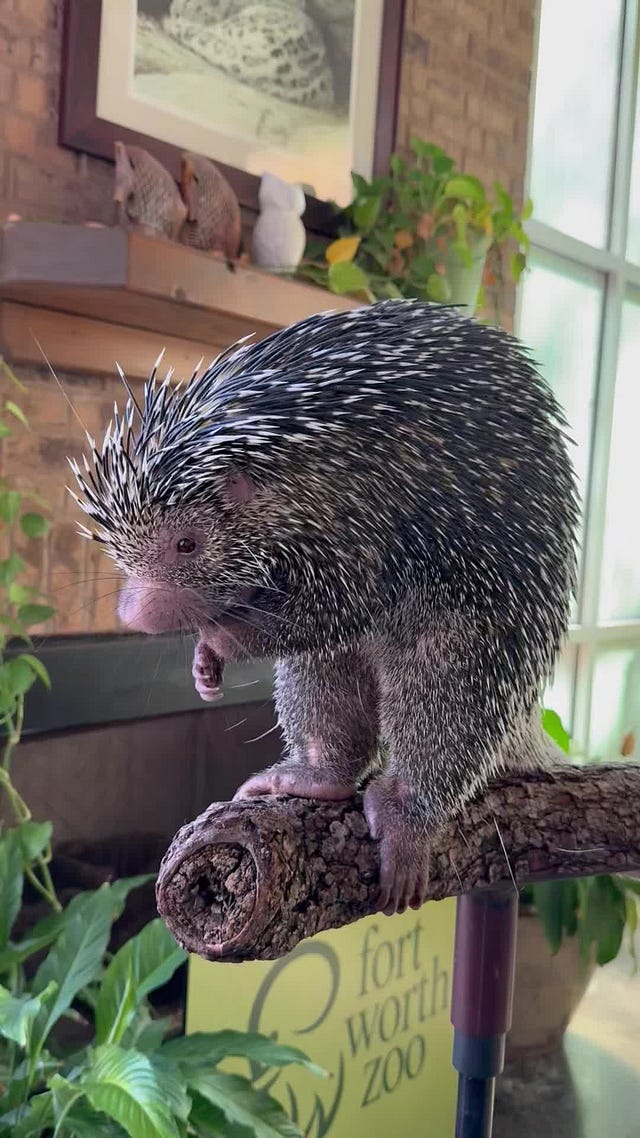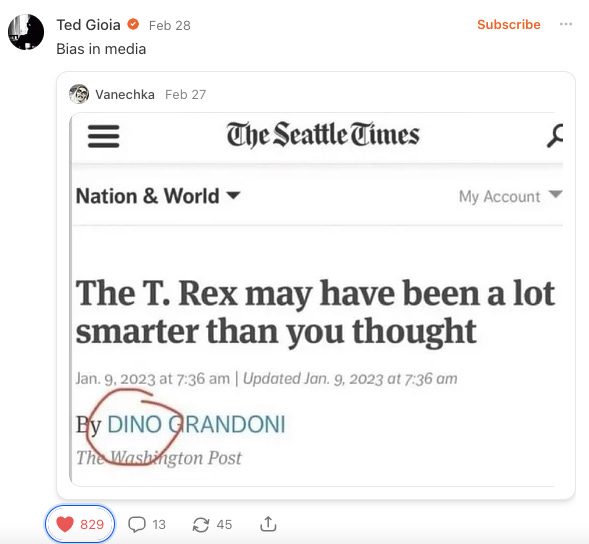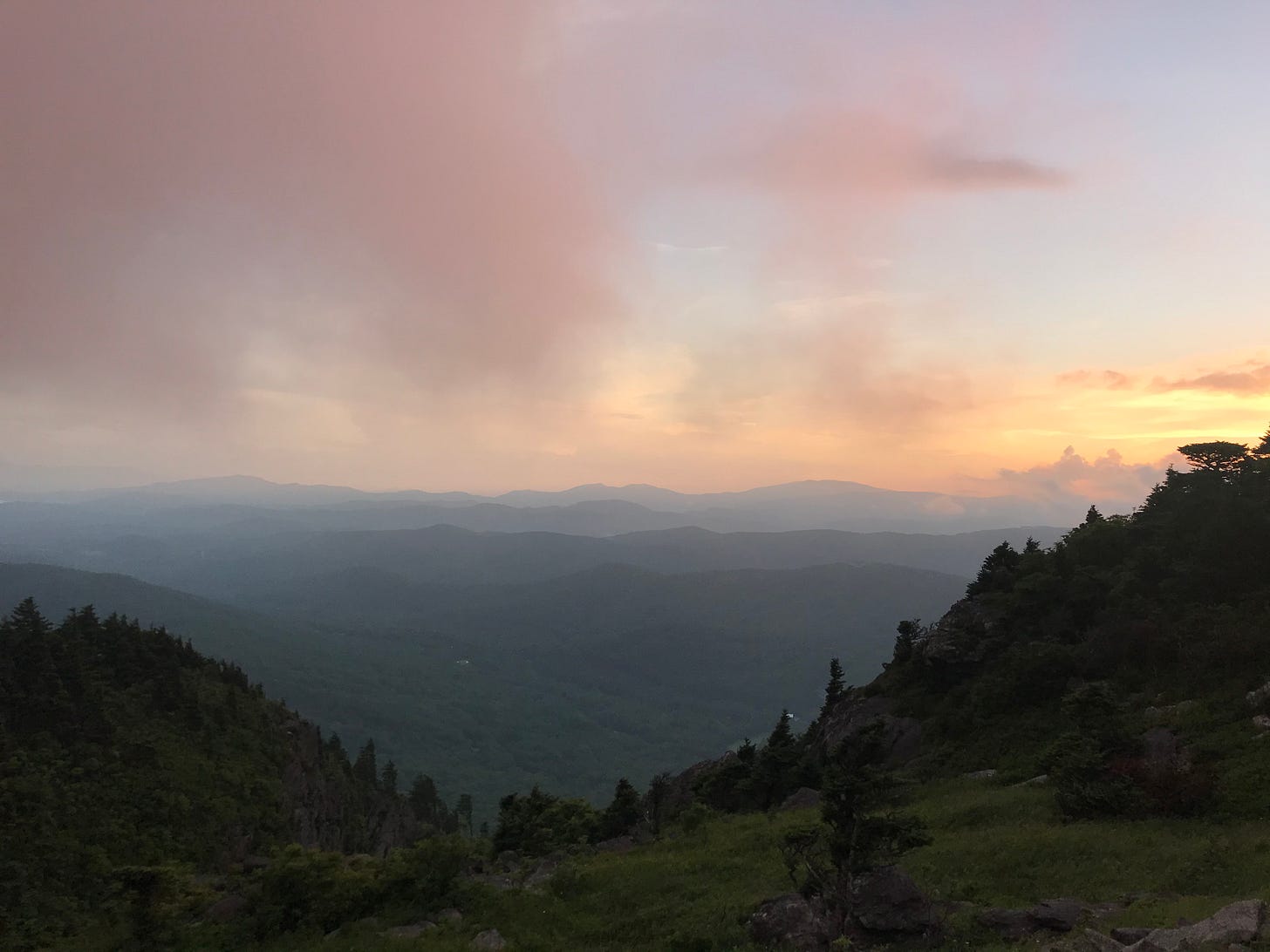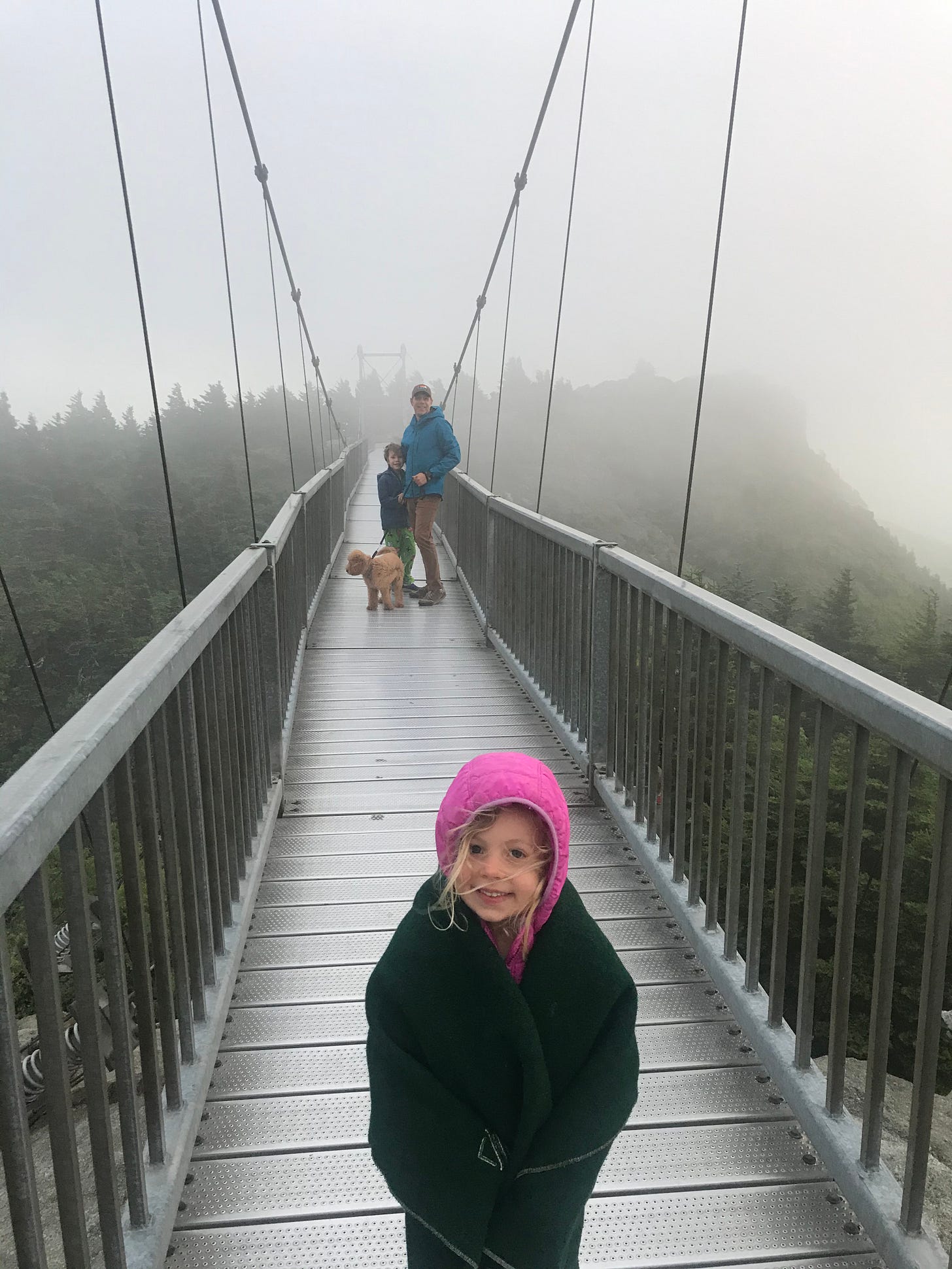Last week was rough; it felt as though I was being bombarded from several different directions.
How are you feeling today? Right now?
Today’s post is taken in part from something I started writing a while ago. I hope it’s not too disjointed. In times of extreme turmoil and conflict and uncertainty, I’ve found it helps to remember I’ve gotten through difficult times before. Hence this small offering.
Before I get to it—more porcupine content.
I’ve long loved this language from a 1973 U.S. House Committee report on the bill that would become the Endangered Species Act (bold emphasis mine):
Man’s presence on the Earth is relatively recent, and his effective domination over the world’s life support systems has taken place within a few short generations. Our ability to destroy, or almost destroy, all intelligent life on the planet became apparent only in this generation. A certain humility, and a sense of urgency, seem indicated…
…As we homogenize the habitats in which these plants and animals evolved, and as we increase the pressure for products that they are in a position to supply (usually unwillingly) we threaten their—and our own—genetic heritage.
From the most narrow possible point of view, it is in the best interests of mankind to minimize the losses of genetic variations. The reason is simple: they are potential resources.
They are keys to puzzles which we cannot solve, and may provide answers to questions which we have not yet learned to ask.
Three months after the COVID19 pandemic hit the U.S., in March of 2020, my husband and I loaded our kids and the dog into the car and headed for the mountains, three hours west. We were going there to accept an unusual invitation: Photinus carolinus, the only North American species of firefly known to make synchronized light displays, had just been discovered on Grandfather Mountain in the Blue Ridge, and though it was closed to the public after dark, we’d been granted special access by the Executive Director, who my husband knew from his work with the Audubon Society. We joked that this was the conservationist’s equivalent of being invited behind a nightclub’s velvet rope.
There are over two thousand species of firefly, found on every continent except Antarctica—but only a handful synchronize their light displays, and only during mating season, which lasts about two weeks a year. The fireflies on Grandfather had been discovered after an entomologist from NC State University, spending the night there for other research, happened to witness the synchronization as it was happening. During such displays, male fireflies send out pulses of light at roughly the same time and in the same pattern, in an effort to attract mates. Scientists hypothesize this creates a mutually beneficial period of darkness in which the males can then search for responses—because the females do respond, sending their own much fainter pulses back out into the night.
In those still-surreal early days of the pandemic, it felt strange to be looking forward to something. Strange, too, to be traveling anywhere—though the risks in this case seemed small enough to merit taking them, and worth the welcome change of scenery. No one was presently occupying the house in which we would stay, in Valle Cruces. We would make the drive without stopping, bringing all our own food. Eating at a restaurant was still unthinkable then; even a gas station bathroom break felt dangerous.
Days before our departure, a friend happened to send a link to live-streaming footage of a synchronous firefly display in the Great Smoky Mountains of Tennessee; like everything else in the world at that time, even natural wonders were going virtual. Unlike the newly discovered population on Grandfather Mountain, the Tennessee fireflies were so well-known that, even before COVID, the number of in-person viewers had to be restricted in an attempt to reduce crowding. A lottery system had been created, in which people could enter their names for a chance at a viewing time, and then those selected were transported to a designated area. Still, the mobs of tourists in and around Gatlinburg during peak firefly season were said to be obscene, and some people feared they might wreck the ecosystem altogether.
As weeks of pandemic disruption stretched on into months, while stuck in the house I’d begun tuning in to wildlife cameras for the first time. Doing so felt like an escape—or at least a reminder of life moving forward in some form, someplace else. Most often I visited a riverbank in an African game preserve, thrilled when I logged on to find elephants or giraffes gathered there to drink. Less often, I checked zoo cameras—in particular, one in a red wolf enclosure at a wildlife center in upstate New York. I’d recently won an arts grant to continue reporting and writing about these critically endangered wolves, but since the pandemic hit I’d had to suspend my travels to wildlife refuges in eastern North Carolina, the only place on Earth where they still live wild.
[Fact check per reader comment: This is true. It was true then, in 2020, and it’s true now. There are promising findings about canids (coyote admixtures) with high levels of red wolf DNA discovered in Southwest Louisiana and eastern Texas, but they aren’t officially identified as red wolves, at least not yet. There is an island off the coast of Florida where red wolves also live, but it’s a National Wildlife Refuge and considered a “propagation island” for the population, and is home to several other endangered species as well].
My interest in red wolves had been kindled a couple of years before the pandemic, also during a time of grief and confusion—at least for me. 2018 was the year of the massacre at Marjorie Stoneman Douglas High School, of Trump’s horrific family separations policy, and of #MeToo’s public reckoning for predators like Harvey Weinstein, which had stirred in me complicated feelings of relief and regret. As I’ve already noted in this SubStack, amidst the barrage of dismaying news reports, the announcement of a litter of red wolf pups, born at the science museum near my house, had seemed a ray of light—a tangible symbol of hope for this once-doomed species, part of the captive breeding program keeping them from extinction.
I would soon learn that red wolves had rebounded from the brink of extinction once before, as part of a groundbreaking experiment in re-wilding, when an initial eight captive-born pairs were released from captivity onto the rural Albemarle peninsula in the late 80’s. After decades of slow and steady growth there, the wild population had begun to plummet around 2012, and wild red wolves were now again in danger of disappearing from the earth. Less than twenty remained in the wild, and only about two hundred in zoos and nature centers across the country.
[Cut from this section: description of the stress-induced/PTSD-related meltdown I experienced in the summer of 2019—almost a year to the day before our arrival in the mountains. This is the place where many SubStacks might say, “the rest of this is for subscribers only,” but I don’t know how to do that without a paywall, so I’m just cutting it all out right now. Instead, I’ll post a meme that made me smile]
We were pleased to find the mountain house was lovely: roses on a white picket fence out front, a steep, treed hillside sloping up behind the lawn. The only sounds were the calling of birds and the burbling of a stream across the road. Inside, dark wooden floors gleamed, and bookshelves were lined with field guides to native plants and animals. With the windows open and breezes sweeping the house, we could breathe freely.
A page marked in a coffee table book informed us that this house was originally a church—St. Anthony’s, tiny country outpost of a larger Episcopal congregation in a nearby town. I remembered from my Catholic youth that Saint Anthony was the patron saint of lost things.
Almost exactly one year prior to this mountain trip, in the summer of 2019, I’d briefly lost my mind. [Per note above: welp, I guess I’ll include some of it]. The predominant feeling I’d had, during those harrowing hours, was that the self I knew was gone forever. This incident happened before the pandemic, and in the months following I gradually resumed the life I’d known—albeit an altered version, forced as I was to abandon previous projects and passions to focus almost solely on my health, for my family’s sake. Still, aftershock-like panic attacks continued to plague me for months after the “heralding event,” a term for that initial, horrific experience of dissociation.
In storytelling and mythology, the herald archetype is the motivator, the call to adventure. In psychology, a herald is a signal triggering the realization that change is needed, “that the world is unbalanced and needs to be set right again.” Unbalanced was a fair description of my life in that year leading up to my collapse. After Trump’s election, I’d plunged headlong into activism, and by 2018 was the leader of my city’s chapter of a national gun violence prevention group. At the same time, I was trying to finish a long-overdue novel and care for two young children with minimal help. The daily news was a horrifying onslaught of racism, fascism, and melting ice caps [I’ve used this phrasing in another post, I think]; petty infighting and bureaucracy were threatening to derail all the hard work our volunteer-led organization had done over many months—and to top it all off, my beloved dog was dying. It was a recipe for a meltdown of some kind, even without unresolved trauma from the past bubbling up, which I would later understand as the ultimate catalyst for my unraveling.
We spent the next few days at the mountain house hiking, reading, and playing in the yard. Aside from the occasional car flying past or hiker on some wooded trail, we encountered no one. We roasted marshmallows, waded into the frigid pools beneath waterfalls, and slept out in a tent, something my children had never done before. We had no idea yet how long our isolation would last—that school would stay closed for twelve months, or that three years on I would be writing this account as yet another variant surged around us, the virus having already killed millions around the world.
On the appointed evening, we drove to Grandfather Mountain at dusk. In addition to having been granted V.I.P. firefly access, we’d also been invited to watch the sunset from the mountaintop. After being waved through the gates, we drove up a curving, paved road toward the summit, my husband explaining as we did that sixteen distinct ecological communities could be found on this single mountain, some of which existed nowhere else on the planet. As we ascended, we entered forests of Red Spruce and Fraser fir, trees more commonly found in northern climes, and the ecosystems continued to evolve around us as we climbed.
The road ended at a deserted parking lot, and we ascended a final staircase on foot to reach the “Mile-High Swinging Bridge,” so named for its elevation at over 5,000 feet. From this vantage, a stretch of metal hung by suspension cables straddling a chasm between two peaks, we looked out at ridges and valleys stretching on into the distance, fading into increasingly pale shades of blue. The trees below were hard to distinguish, a carpet of green rolling on without end. As we crossed the bridge, single file, a sudden fog came rolling in, obscuring the view. We were disappointed until we realized that it was a cloud—we were walking in a cloud! We could feel its cold kiss on our cheeks, open our hands and watch it trail through our fingers.
The mountain solitude was broken then by the unexpected sound of voices. Two men appeared on the bridge out of the cloud-fog, heading in our direction. Their arrival was startling not only because they seemed to appear out of nowhere—we hadn’t seen or heard a car pull up—but also because we’d been told we were the only people left on the mountain, or at least within the managed park. Staff at the entrance had granted us access before closing the gates for the night.
My husband and I were standing with our children on a narrow outcropping that dropped off sharply on all sides. I had already been feeling nervous about the possibility of someone falling. There was no way to get to our car without crossing the bridge back to the other side, past these men.
If they were at all startled to find us there, appearing out of the mist on the far side of the bridge, they didn’t show it. “Have you seen a cell phone?” one of them asked, scanning the ground around us.
Even here, it seemed, on this isolated mountaintop, we couldn’t escape the human world, or the potential it held for violence—benign though these phone-seekers turned out to be.
The strange bouts of vomiting and vertigo that had debilitated me in the months before my collapse had been symptoms of post-traumatic stress—a delayed response to an assault I’d experienced decades earlier. This was hard to accept, in part because I blamed myself for what had happened to me, for putting my body in danger; I should have been more vigilant, more aware of the risk of predators.
Perhaps my obsession as an adult with disappearing things of beauty—my lingering fascination with red wolves, for example, and the furious debate over whether they deserved to exist—was result of my own uncertainty about reality and perception, a wish to define and hold on to things. Perhaps also a desire to make sense of awfulness, to somehow try to integrate it into a life of purpose and meaning.
Only after Barry Lopez’s death did I discover his harrowing essay, “Sliver of Sky,” about reckoning with childhood sexual abuse. The title refers to the glimpse he had out the window during certain unbearable moments in his youth, and how he found small hope in this evidence of a world beyond the place where he was being kept powerless. He credits the natural landscape with helping him emerge from that period, intact—and indeed Lopez went on to have a rich life, full of adventure and beauty and curiosity, traveling and learning and writing books.
The past was always with him, though. In “Sliver of Sky,” Lopez describes returning to the scene of his childhood torment as an adult and simply seeing the name of his former tormentor in a phone book causes him to shit himself. In Chanel Miller’s staggering memoir Know my Name, she has a sudden, violent vomiting episode, months after the trial of her assailant has ended. Reading these accounts of delayed physical responses to trauma, I felt a melancholy recognition. I, too, knew the powerful, confounding experience of one’s own body calling for help, too late. How it could feel like a betrayal.
view of the mountains from the swinging bridge
my little family, early pandemic days
After sunset we descended to a lower elevation where the Executive Director of the mountain’s stewardship foundation and his young son were waiting for us at a scenic overlook. Our boys were the same age, and within moments they were lost in conversation about Minecraft. Playing this online game with friends over Zoom had been one of the few social connections they had been able to maintain during ongoing quarantines. Even though we were outside, the boys wore face masks; we had to keep reminding them to stand further apart. Pandemic precautions were still new to us all.
We waited for night to fall. Bats swooped past into the gloom. After a while, flashes of bioluminescence began to appear, here and there. No synchronization yet. Tonight was a full moon, we were told—not ideal for viewing. We decided to venture down the road further into the trees, in hopes of finding more sufficient darkness.
As we walked, the director told us about several endangered species found on the mountain: the spruce fir moss spider, the bog turtle, the eastern small-footed bat. I asked him if the synchronous fireflies were endangered, and he explained that though fireflies in general are at risk, their habitats ever-diminishing due to human encroachment, it wasn’t certain yet if this population had evolved to become a distinct subspecies of Photinus carolinus. Since they would spend their entire lives on this mountain, though, it was in a sense their whole world. The mountain’s stewards would be thoughtful moving forward about how to increase public awareness of them without putting the fireflies at greater risk—always a tricky prospect.
Years ago, when I’d asked my husband if he thought I was fragile—too prone to worry—he reassured me, “You’re good in a crisis.” Then he thought a moment before clarifying, “a true crisis.” This confirmed what I already suspected: that I sometimes obsess over trivial matters, perhaps because they seem controllable. I wondered now, immersed as we were in as true a crisis as I could fathom, if he still saw me that way—if it was possible to remain “good,” unruffled and dependable, when a crisis was so fundamental, so far-reaching, with no end in sight. I was reminded of how my husband, having worked in the trenches of environmental conservation for his entire career, used to joke that he allowed himself “one day of despair per week,” to be able to keep moving forward despite increasingly bleak challenges.
I was surprised to realize that what sustained me now, in this time of plague, in addition to simple human kindnesses—pick-me-up flowers left on a doorstep; “meal trains” set up to feed the family of a sick friend—was time spent in nature; not the abstract “nature” of a forest I might visit on occasion, or some remote peak in the Blue Ridge, but the nature I was surrounded by every day, as dependent on me as I was on it. The wasp, building her nest outside our windowpane—the total devotion with which she crafted each delicate, papery cell; the swaying of trees in the hot wind outside a hospital window. These were my own slivers of sky.
On the mountain, more lights seemed to be flashing around us now, more insistently. The director confirmed that the synchronization had begun. He counted somewhere between four and seven flashes between longer pauses. As with rests in a musical composition, the pauses were essential in order for the fireflies’ messages to be received.
In one of Alan Watts’s recorded talks on the nature of the universe, he explains that, contrary to common perception, space is not empty nothingness. Far from it. In some cultures, it’s thought to be the foundation of the world, even a proxy for God. “The usefulness of the vase,” Watts says, “is not so much in the sides, made of clay, as in the hollow inside, in which something can be put.” Architects, painters, photographers, and composers must understand this concept—that the intervals between objects have just as much significance as the objects themselves.
The forest had come alive now, sparking with urgent messages. Real beauty, Lopez once explained in an interview, was so deep that one had to move into darkness to comprehend it.
“Look,” I whispered to my daughter. She was grumpy, starting to whine, hours past her bedtime. I hoisted her onto my hip. “See? They’re like fairies.” I wanted to convey to her the magic we were seeing; that even then, in the midst of our dreadful pandemic reality, it was still there.
After a while, though, my arms grew tired; I passed her to my husband. He and the director were talking in animated voices about potential future activities on the mountain. The boys nearby were still babbling on about Minecraft. Noise wasn’t thought to disturb the fireflies, but it was disturbing me—making it hard for me to fully enjoy what was happening, the phenomenon we were lucky to witness.
“Can everyone please be quiet for a minute?” I blurted, and to my surprise, their voices trailed off. I moved away from them, deeper into the trees.
For a few moments, we stood there together in rapt silence, waiting in the sacred dark. Then the night erupted again, filled with such brilliant illumination—all those tiny beings, glowing in unison, making their patterns, signaling each other in a language we weren’t meant to understand.










Beautiful post. All of it. Your stories, your bouncing to new themes all connected and your writing of the red wolves and….all wolves is a refuge. Would love to some day read your thoughts on coyotes…. The most persecuted (by numbers) and misunderstood of all the North America canids.
Hello Meaghan. I just read your beautiful post thank you. You are a lovely writer and you brought me home again. I am waiting for a flight home out of Australia. The one I was supposed to leave on today is canceled so I’m alone in hotel room just wishing I was home through all the time zones and everything. We are indeed tiny dots in a huge huge world, I feel fortunate to live close to you